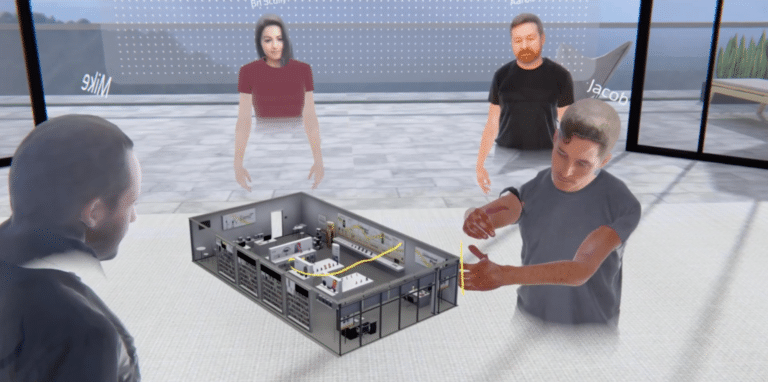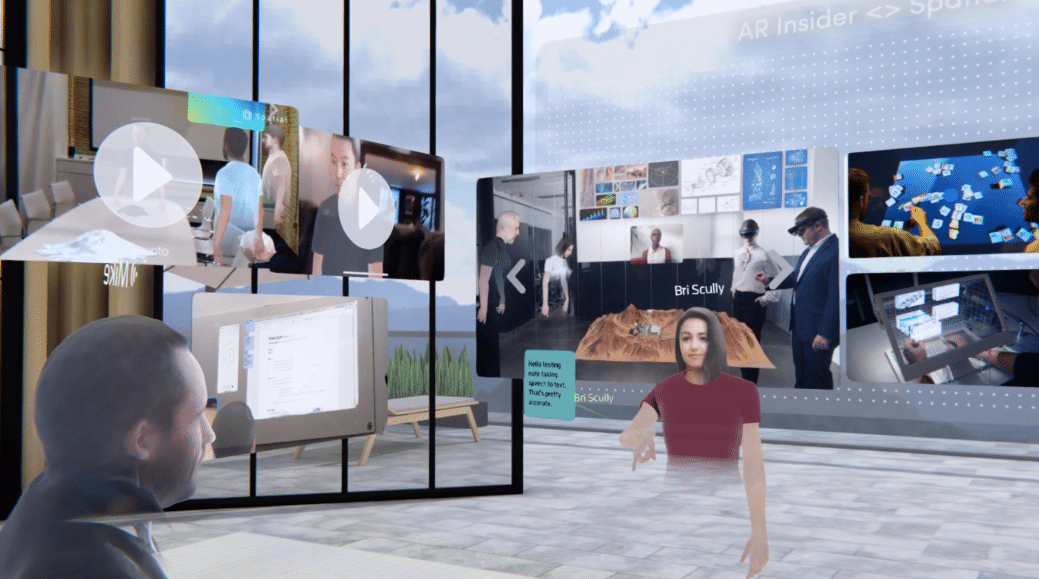
AR Insider Interviews is a series that profiles spatial computing innovators. Narratives are based on interviews with subjects, but opinions and analysis are that of AR Insider. For an indexed library of spatial computing insights, data, reports and multimedia, subscribe to ARtillery PRO.
The fun and sometimes-bizarre thing about spatial computing analysis is how meta it can be. Subjects are sometimes discussed within the mediums they represent. We’ve been planning an upcoming AWE Nite SF in Altspace VR — talking about VR to a VR-centric audience while in VR.
An even greater moment came in a recent briefing with the team at Spatial. Naturally, the venue of choice was Spatial itself. For those unfamiliar, Spatial lets far-flung teams collaborate in a shared virtual space through a variety of devices. It just won the Auggie for Best Enterprise Solution.*
As we’ve examined, benefits include bringing together the best of remote work (convenience, cost, carbon footprint), with the best of in-person work (human interaction, spatially-accurate collaboration). And these benefits are amplified for the current shelter-in-place masses.
This timing prompted Spatial to launch on Oculus Quest and make its PRO tier free. The former is part of its drive to reach users across devices including smartphones. Following Quest’s demand signals, this widens Spatial’s addressable market for immersive collaboration to a $399 device.
With that backdrop, we met Spatial in Spatial for a wide-reaching discussion about its design principles, recent moves, current positioning, and future aspirations. Here’s the deep dive.

Innate Cognition
Starting at the beginning, the Spatial user experience (UX) is the first thing you’ll notice when entering the app (I accessed via Oculus Quest). One common trait of virtual collaboration and social VR apps is lots of onboarding friction. Designing around that it is easier said than done.
Of all those we’ve experienced — including apps known to be most user-friendly like Altspace and RecRoom — Spatial outperforms in ease of setup and session launches. In fairness, it’s a different product with a different set of goals and use cases, but these are close comparisons.
Specifically, there’s a standard set of onboarding steps that are common to many immersive social or collaboration apps, including avatar setup, orienting controls, finding the right room/group, and generally getting a comfortable sense of agency. These were all easy and intuitive in Spatial.
Then, there’s the matter of UI and interactions. Here too, everything is well designed and intuitive without imposing new “languages” and abstraction layers. It’s rather designed to align with your innate cognition around things like grabbing, pulling and expanding digital objects.
This is by design says VP of BD and Strategy, Jacob Lowenstein. It’s the fruits of lots of rigor, and the design principles of Spatial’s founding team including Jinha Lee (MIT, Microsoft, Samsung) and Anand Agarawala. Its head of design also helped develop Material Design at Google.


Faster Horses
With that UX as a foundation, the question becomes feature refinement and go-to-market strategy. Here, Spatial has designed towards use cases for which spatially-oriented interaction is inherent. That includes agile scrums, with their shared spaces and signature color-coded Kanban boards.
Product design and retail planning are also fitting use cases, and Spatial works with customers to ingest feedback to help steer that road map. That includes the work it’s done to support collaborative industrial design for toy manufacturers like Mattel, and car manufacturers like Ford.
Here there’s a notable balance between Spatial’s own intuition on where it should go, and the feedback it internalizes from customers and the broader market. The former invokes the Henry Ford (mis)quote about eschewing customer sentiment that would only lead to faster horses.
That steadfast vision — which Steve Jobs was also known for — engenders resilience that’s a survival imperative in the bumpy road to bringing a product to market. But balance and a measured dose of market realities should also be internalized through some degree of listening.
Spatial has done that by fine-tuning to customer specifications. For example, fashion designers help it refine interactions around visualizing and designing a handbag, says Spatial’s Bri Scully, compared to corresponding feedback from auto companies about the nuances of car design.

Ambient Collaboration
Extrapolating forward, what can we expect from Spatial? It will likely continue cross-platform support including low-cost headsets like nreal Light, as well as iOS & Android apps. We could also see more native integration of 3D model libraries, which it currently does with Google Poly.
Another use case it’s beginning to observe and design towards is ambient collaboration. As we’ve examined, this transcends active or scheduled meetings in favor of a sort of persistent colleague presence that’s occasionally activated as the need to speak up or share ideas organically arises.
This is how humans are naturally inclined to behave at work, and sort of emulates the way we act in physical offices. For Spatial, instead of walking down the hall or popping in to someone’s office with a question, you could pop up virtually in their peripheral view (if permissioned of course).
These are timely use cases in that they’re quarantine-friendly. And that’s proving out in both demand and usage. Spatial’s Aaron Dence reports 1000 percent uptick in incoming interest above pre-Covid levels, while usage among existing users has likewise increased 1000 percent.
Also notable is that 80 percent of the inbound interest during this period has been small and medium-sized businesses (SMBs). This is promising in that it opens up a long-tail opportunity in Spatial’s revenue growth… and gives it another set of design targets for its road map.

Silver Linings
Speaking of Covid, Spatial’s road map is influenced by situational factors, Like every tech company, global lockdowns have affected its strategy. Along the spectrum of negative impact (high-touch businesses) to positive (e-commerce and remote-work), Spatial is closer to the latter.
Put another way, Spatial’s business is well-positioned for a remote-work cultural shift. It’s reacted nimbly, including the limited-time free Pro tier noted earlier. This could be smart to introduce and expose the product to users at a time when the ground is fertile for remote collaboration tools.
Oculus Quest support likewise follows the device’s growth, especially for shelter-in-place use. This traces back to Spatial’s long-held strategy to not cut off its own network effect through compatibility hurdles, which is why it also operates on 2D web. So we can expect more platform support.
But the biggest accelerant is cultural. As we’ve examined, and as Lowenstein presciently observed last year, remote work could be permanently transformed. It’s prevalent now by necessity, but new perspective could be gained through that process, and instill long-term behavioral change.
“The world has been forced into a giant work-from-home experiment,” said Lowenstein. “And we’ve basically learned it’s mostly fine […] I think you’re going to find that people will be working from home a lot more. [We’ll] see broad exposure because of this giant shift in the way the world is. And it’s going to persist because the world is not going to go back to the way it was before.”
See Charlie Fink’s latest book that goes deeper on the new age of remote collaboration and virtual events.
*Editor’s note: the author of this article was a judge for the Auggie Awards, but has no financial relationship with the entities named in this piece. See disclosure and ethics policy here.
